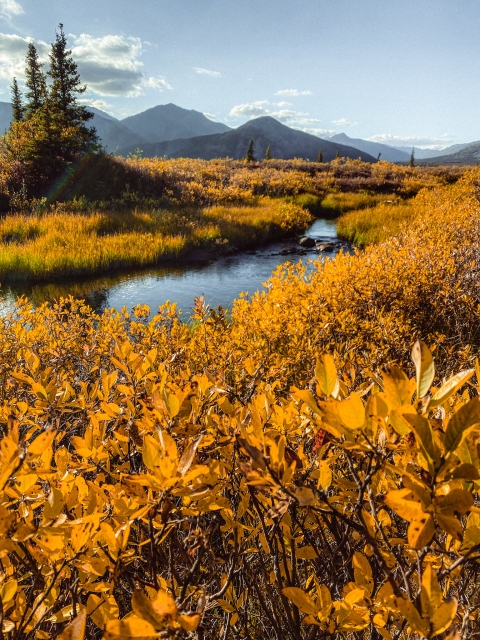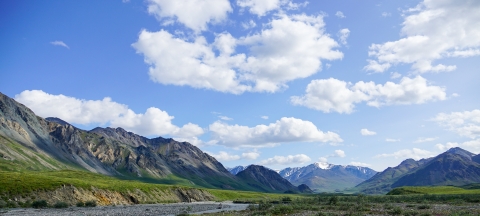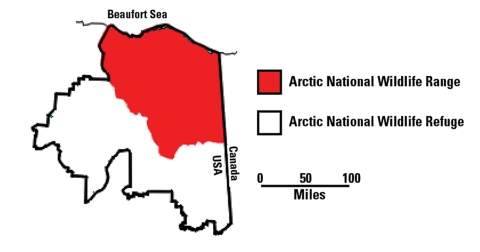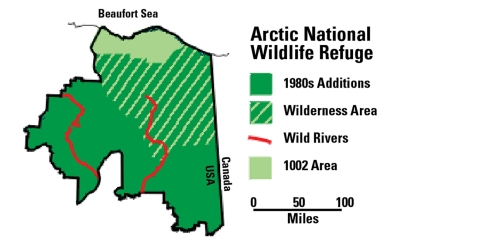About Us
America's largest and northernmost refuge covers a huge swath of remote lands and waters in the northeast corner of Alaska, including the homelands of the Iñupiat people of the north coast and the Gwich'in people of interior Alaska and northwest Canada. It contains the largest area of designated Wilderness in the National Wildlife Refuge System and three of its rivers (Sheenjek, Ivishak, and Wind) are designated Wild and Scenic Rivers Wild and Scenic Rivers
The Wild and Scenic Rivers Act of 1968 established the National Wild and Scenic Rivers System, and authorizes Congress to preserve certain rivers with outstanding natural, cultural and recreational values in a free-flowing condition for the enjoyment of present and future generations. The act is notable for safeguarding the special character of these rivers, while also recognizing the potential for their appropriate use and development. The act encourages river management that crosses political boundaries and promotes public participation in developing goals for river protection.
Learn more about Wild and Scenic Rivers .
Stretching 200 miles from the Arctic Ocean south over the Brooks Range and into the boreal forest of the Yukon River basin, this 19.64-million acre refuge encompasses five different ecological regions: coastal marine, coastal plain tundra, alpine tundra, forest-tundra transition, and boreal forest. These lands and waters are home to some of the most diverse and spectacular fish and wildlife in the arctic, from polar bears to caribou, Dall sheep, muskox, salmon-sized Dolly Varden char, and Arctic Grayling. Birds from all over the world come here to breed, feed, and rear their young. Conserving these populations and their habitats in their natural diversity is a purpose of the refuge.
The Eisenhower administration established the 9-million-acre Arctic National Wildlife Range in 1960 to preserve unique wildlife, wilderness and recreational values. In 1980, the Alaska National Interest Lands Conservation Act (ANILCA) re-designated the range as part of the larger Arctic National Wildlife Refuge, with nearly 40 percent of the refuge designated as Wilderness.
Two of the most active and influential proponents for creating a northern refuge were Olaus Murie, long-time Alaska biologist and director of The Wilderness Society, and his wife Mardy. While they worked toward establishment of the refuge, they also worked with Olaus’s partner at The Wilderness Society, Howard Zahniser, to enact new legislation that would eventually become the 1964 Wilderness Act.
Our Mission
Vision
This untamed arctic landscape continues to sustain the ecological diversity and special values that inspired the refuge’s establishment. Natural processes continue, and traditional cultures thrive, with the seasons and changing times; physical and mental challenges test our bodies, minds and spirit; and we honor the land, the wildlife, and Indigenous people with respect and restraint. Through responsible stewardship, this vast wilderness is passed on, undiminished, to future generations.
Refuge Purpose(s)
Each unit of the National Wildlife Refuge System is established to serve a statutory purpose that targets the conservation of native species dependent on its lands and waters. All activities on those acres are reviewed for compatibility with this statutory purpose.
Arctic Refuge was originally established in 1960 as the Arctic National Wildlife Range to preserve “unique wildlife, wilderness and recreational values.” The Alaska National Interest Lands Conservation Act (ANILCA) expanded the Refuge in 1980, and provided new purposes for the entire refuge:
- To conserve animals and plants in their natural diversity,
- ensure a place for subsistence hunting and gathering activities,
- protect water quality and quantity,
- and fulfill international wildlife treaty obligations.
- Added in 2017: to provide for an oil and gas program on the Arctic Coastal Plain.
Our History
Archeological evidence shows human habitation by Indigenous peoples for thousands of years on these lands. Iñupiat and Gwich'in people live here now, as generations of their ancestors have done for millenia.
1903: President Theodore Roosevelt established the National Wildlife Refuge System, designating Pelican Island in Florida as its first unit.
1950: The National Park Service began a recreational survey in Alaska to identify areas with special natural values.
1954: The National Park Service recommended that the undisturbed lands in the northeastern corner of Alaska be preserved for their wildlife, wilderness, recreation, scientific, and cultural values.
1957: The Department of Interior announced plans to ask Congress to establish an 8,000 square-mile wildlife reserve in the area identified by the National Park Service study.
1960: The Secretary of Interior in the Eisenhower administration signed a Public Land Order establishing the 8.9 million acre Arctic National Wildlife Range.
1964: President Lyndon Johnson signed the Wilderness Act, establishing the National Wilderness Preservation System and provisions for wilderness use and protection.
1968: President Lyndon Johnson signed the Wild and Scenic Rivers Wild and Scenic Rivers
The Wild and Scenic Rivers Act of 1968 established the National Wild and Scenic Rivers System, and authorizes Congress to preserve certain rivers with outstanding natural, cultural and recreational values in a free-flowing condition for the enjoyment of present and future generations. The act is notable for safeguarding the special character of these rivers, while also recognizing the potential for their appropriate use and development. The act encourages river management that crosses political boundaries and promotes public participation in developing goals for river protection.
Learn more about Wild and Scenic Rivers Act, establishing the National Wild and Scenic Rivers System, which protects designated rivers as either wild, scenic, or recreational.
1969: The first manager was hired for the Arctic National Wildlife Range.
1971: President Richard Nixon signed the Alaska Native Claims Settlement Act (ANCSA). The Act gave the Kaktovik Inupiat Corporation (KIC) surface rights to 92,160 acres of federal lands adjacent to the village. ANCSA allowed 69,120 of these acres to be selected within the Arctic Range and the remaining lands to be selected outside the Range.
1980: President Jimmy Carter signed the Alaska National Interest Lands Conservation Act. The Act re-designated the Range as part of the larger, approximately 18 million acre Arctic National Wildlife Refuge, designated eight million acres as Wilderness, and designated three rivers as Wild. It also called for wildlife studies and an oil and gas assessment of 1.5 million acres of the Refuge Coastal Plain. In addition, ANILCA allowed the Kaktovik Inupiat Corporation on Barter Island to relinquish their selected lands outside the Refuge and instead to select the remainder of their Corporation lands within the Arctic Refuge. Section 1003 of ANILCA stated that the "production of oil and gas from the Arctic National Wildlife Refuge is prohibited and no leasing or other development leading to production of oil and gas from the [Refuge] shall be undertaken until authorized by an act of Congress."
1983: The Chandler Lake land exchange agreement conveyed subsurface ownership of KIC lands from the federal government to the Arctic Slope Regional Corporation. This exchange also allowed an exploratory oil well be drilled on KIC lands. Exchanged lands can not be developed until Congress opens the Refuge coastal plain for such activities.
1983: Nearly one million acres were added to the south side of the Refuge when the State of Alaska decided not to retain control of lands it had selected under the Statehood Act.
1987: The governments of the United States and Canada signed an international agreement for management and long-term protection of the Porcupine Caribou herd.
1988: Congress added 325,000 acres to the south side of the Refuge, bringing the total area managed by the Refuge to approximately 19.3 million acres and making Arctic the largest Refuge in the National Wildlife Refuge System.
1997: President William Clinton signed the "National Wildlife Refuge System Improvement Act." This Act provided specific guidance to the Refuge System, and established the mission of the National Wildlife Refuge System "to administer a national network of lands and waters for the conservation, management, and where appropriate, restoration of fish, wildlife, and plant resources and their habitats within the United States for the benefit of present and future generations of Americans."
1997: The U.S. Supreme Court reaffirmed that the barrier islands and the lagoons which they enclose, along the northeast coast of Alaska, are within the boundaries of the Arctic Refuge.
2017: President Donald Trump signed the Tax Cuts and Jobs Act in 2017, which provided for an oil and gas program on the Refuge's Coastal Plain.
Refuge Managers
Ave Thayer
Glenn Ellison
Jim Kurth
Richard Voss
Brian Glaspell
Steve Berendzen
Merben Cerbrian







